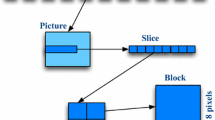Abstract
In recent years, usage of multimedia applications has increased dramatically, especially after the evolution of 3G and 4G technologies. Moreover, the development of new user devices, such as laptops, Smartphone, etc. increased very steeply and rapidly, to support different types of services and different means of communication satisfying user’s needs. Here, the challenge is how to make those services available to users with a high quality; we speak here about quality of service (QoS) and quality of experience. In this survey, we examine different characteristics of wireless networks to determine the enhancements introduced by each technology. Particularly, we focus on the benefits and limitations of three main technologies which are WiMAX, UMTS and LTE, and the role of each one in increasing QoS satisfaction for multimedia application. A comparison is also done between researches already published in Multimedia quality evaluation over wireless networks topic, taking into account some considerations, such QoS parameters, used simulator, assessed applications, etc. All those help us to extract the strengths and limitations of those researches.












Similar content being viewed by others
References
Nivor, F., Gineste, M., Baudoin, C., Berthou, P., & Gayraud, T. (2008). Cross-layer anticipation of resource allocation for multimedia applications based on SIP signaling over DVB-RCS satellite system. In IP networking over next-generation satellite systems (pp. 77–90).
Kavas, A. (2007). Comparative analysis of WLAN, WiMAX and UMTS technologies. In PIERS proceedings, Prague (pp. 140–144). Czech Republic.
OPNET 14.5 PL0 documentation.
Jadhav, S., Zhang, H., & Huang, Z. (2014). Performance evaluation of quality of VoIP in WiMAX and UMTS. In 12th international conference on parallel & distributed computing, applications and technologies (PDCAT) (pp. 375–380).
Anouari, T., & Haqiq, A. (2014). Performance analysis of VoIP traffic in WiMAX using various service classes. International Journal of Computer Applications, 9, 230–241
Anthony, L., Geert, H., & Ignas, N. (2005). Performance evaluation of MPEG-4 video streaming over UMTS networks using an integrated tool environment. In International Symposium on Performance Evaluation of Computer and Telecommunication Systems (SPECTS).
Imran, A., & Samuel, A. O. (2010). Evaluation of video quality of service in 3G/UMTS wireless networks as succor for B3G/4G wireless network.
GPP 23.107 V7.4.0. (2006). Quality of service (QoS) concept and architecture. http://www.3gpp.org/dynareport/23107.htm.
Long Term Evolution (LTE). (2007). A technical overview. Technical White Paper.
Abed, A., Ismail, M., Badrawi, I. & Sabbar, M. (2013). An empirical model of correlated traffics in LTE-advanced system through an innovative simulation tool. In International science index (pp. 780–783).
Araniti, G., Campolo, C., Condoluci, M., Iera, A., & Molinaro, A. (2013). LTE for vehicular networking: A survey. IEEE Communications Magazine, 51, 148–157.
Adhicandra, I. (2010). Measuring data and VoIP traffic in WiMAX networks. Journal of Telecommunications, 2, 1–6.
Lee, H., Kwon, T., Cho, D. H., Lim, G., & Chang, Y. (2006). Performance analysis of scheduling algorithms for VoIP services in IEEE802.16e systems. In IEEE 63rd vehicular technology conference (pp. 1231–1235).
Naqvi, A. N., Abbas, A. M., & Chouhan, T. A. (2012). Performance evaluation of fixed and mobile WiMAX networks for UDP traffic. International Journal of Advanced Research in Computer and Communication Engineering, 1, 6079–6084.
Talwalkar, R. A., & Ilyas, M. (2008). Analysis of quality of service (QoS) in WiMAX networks. In ICON IEEE (pp. 1–8).
Jha, R. K., Bholebawa, I. Z., & Dalai, U. D. (2011). Location based performance of WiMAX network for QoS with optimal base stations (BS). In Wireless engineering and technology.
Sedoyeka, E., Hunaiti, Z. & Tairo, D. (2010). Evaluation of WiMAX QoS in a developing country’s environment. In IEEE/ACS international conference computer systems and applications (AICCSA) (pp. 1–6).
Barbaresi, A., & Mantovani, A. (2007). Performance evaluation of quality of VoIP service over UMTS UTRAN R99. In International conference on communications (ICC’07) (pp. 634–639).
Khan, M. M., & Khan, M. S. (2010). Investigation of handovers in 3G UMTS traffic classes. Blekinge Institute of Technology.
Thilagavathi, J., & Meena, K. (2014). Assessment of quality of experience for video streaming over LTE network. In International Journal of Computer Science, Information Technology & Security (IJCSITS).
Musabe, R., & Larijani, H. (2012). Evaluation of a new scheduling scheme for VoIP with mobility in 3G LTE. In CRTQ IARIA.
Piro, G., Ceglie, C., Striccoli, D. & Camarda, P. (2013). 3D video transmissions over LTE: A performance evaluation. In IEEE EUROCON (pp. 177–185).
Siomina, I., & Wanstedt, S. (2008). The impact of QoS support on the end user satisfaction in LTE networks with mixed traffic. In IEEE 19th International Symposium on Personal, Indoor and Mobile Radio Communications (PIMRC) (pp. 1–5).
Vinayagam, D., Kurinjimalar, R. & Srinivasan, D. (2012). Performance evaluation of cross layer QoS scheduling for long term evolution network. International Journal of Advanced Computer Research, 2, 75–85.
Anas, M., Rosa, C., Calabrese, F. D., Pedersen, K. I., & Mogensen, P. E. (2008). Combined admission control and scheduling for QoS differentiation in LTE uplink. In IEEE 68th vehicular technology conference (VTC) (pp. 1–5).
ITU-R Recommendation BT.802-1. Test pictures and sequences for subjective assessments of digital codecs conveying signals produced according to recommendation ITU-R BT.601-4. http://www.itu.int/rec/R-REC-BT.802-1-199407-I/en.
Video trace library. http://trace.eas.asu.edu.
Piro, G., Ceglie, C., Striccoli, D., & Camarda, P. (2013). 3D video transmissions over LTE: A performance evaluation. In EUROCON (pp. 177–185).
Author information
Authors and Affiliations
Corresponding author
Rights and permissions
About this article
Cite this article
Chaari, H., Mnif, K. & Kamoun, L. Multimedia quality transmission evaluation over wireless networks: a survey. Wireless Netw 22, 2607–2621 (2016). https://doi.org/10.1007/s11276-015-1127-5
Published:
Issue Date:
DOI: https://doi.org/10.1007/s11276-015-1127-5




